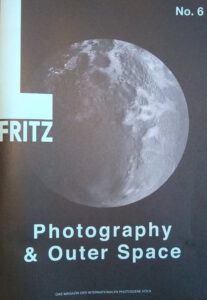@ 2020 Internationale Photoszene Köln gemeinnützige Unternehmergesellschaft (haftungsbeschränkt), die Fotografen und Autoren [und Übersetzer]
Images through Time and Space
On Holly Schmidt and her “Lost Lessons”
By Helena Weber Holly Schmidt Lost Lessons
Glittering galaxies, looming planets, the radiant Orion Nebula, and even the birth of stars – what breathtakingly beautiful and no less awe-inspiring images of the universe space photography has delivered to us!
The first attempts at photographically depicting outer space were made way back in the 1840s. Early on, scientific astronomy recognized the utility of the photograph as evidence and research object at once. And it was astute enough to stage astronautics as a spectacular and publicly appealing media event. Ultimately, the images also served to justify the funding of space travel to the general public. Today, the American astronautics authority NASA is one of the biggest image factories in existence. Solely between 1962 and 1972, more than 30,000 pictures were taken during the Apollo missions; the tally, in the meantime, is already in excess of one million photographs.
Holly Schmidt Lost Lessons
In her work “Lost Lessons”, Canadian artist Holly Schmidt devotes herself equally to such subjects and to the specific image carrier on which they circulate. The starting point of her occupation with outer space are slides specifically produced for teaching and lecturing purposes, which she has been taking from the collection of her father, a professor emeritus of astronomy, since 2014. Originating from a period between 1970 and 1990, the collection covers a diverse array of formats and materials, from photographs through illustrations to diagrams and formulae, and hence illustrates a broad spectrum of information on outer space.
During private slide shows held by her father at home in her childhood, she perceived the contemplation of outer space in the darkened room, in which the whirring and turning of the projector could be heard, as an atmospherically dense, immersive experience. Not yet capable of comprehending the scientific information, she found that an expansive, magical world was opened up to her by the projected slides. “They had something inherently ungraspable”, writes Schmidt, noting that, between the expanses of time and space and the slides’ fleeting historical document, a dissonance arises that fascinates and creates a gap, which she aims to utilize as a space for imagination and reflection.
Holly Schmidt Lost Lessons
There are infinitely many possibilities for combining the slides in order to convey various narratives or ways of knowing. Detached from the scientific narrative, they are open to new interpretations, which Schmidt sounds out in a series of continuous microperformances and astronomical observations. The slide collection is as much part of a collective visual heritage as it is a private archive, with which personal biographical memories are associated. Jointly with her audience she aims to tap into the collection, query the images for their narrative value, and find new stories. Just as Schmidt comprehends her participatory practices as learning in public, her concern, with “Lost Lessons”, is humanity’s relationship to outer space.
For the slides are far, far more than the soberly scientific representation of the universe that surrounds us. “Glorious Eclipses” or “What a View” run some of the titles that are written on the slides. As though they were instructions for reception: “Please be impressed while beholding!”
The story behind the famous photograph “Earthrise” can be read from p. 46: click on the poppy for extracts:![]()
